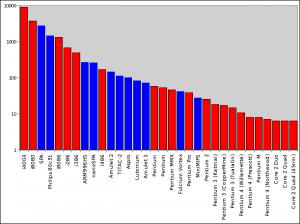Asynchronous processor speeds
 Something that people keep stating which is an outright lie is that asynchronous logic is great for performance and that recent research is making it better and better. Numbers such as “4.6x to 20x” improvement are thrown around as if they mean something. The truth is (sadly) that asynchronous designs are stuck in the early 90s when it comes to performance. The graph shows the number of inversion delays per instruction on a range of intel processors (in red) versus the ones from the asynchronous community (in blue). Because the numbers are technology independent, you can make a fair comparison of the designs should they be implemented on the same technology. The asynchronous designs are now a factor of 10 behind. On the positive side, because the asynchronous community is so far behind, the 1 million transistor designs are minute in comparison to the industry leading 1 billion transistor implementations.
Something that people keep stating which is an outright lie is that asynchronous logic is great for performance and that recent research is making it better and better. Numbers such as “4.6x to 20x” improvement are thrown around as if they mean something. The truth is (sadly) that asynchronous designs are stuck in the early 90s when it comes to performance. The graph shows the number of inversion delays per instruction on a range of intel processors (in red) versus the ones from the asynchronous community (in blue). Because the numbers are technology independent, you can make a fair comparison of the designs should they be implemented on the same technology. The asynchronous designs are now a factor of 10 behind. On the positive side, because the asynchronous community is so far behind, the 1 million transistor designs are minute in comparison to the industry leading 1 billion transistor implementations.
Area is not an issue, asynchronous designs are so far behind we can happily throw area at the problems and continue to do so for a good while. While with performance, lets face it, it is damn poor and creating and recreating the same poor performance designs and then claiming they are several times faster than the incredibly slow designs (see far left of the graph) is fruitless.
No comments yet.